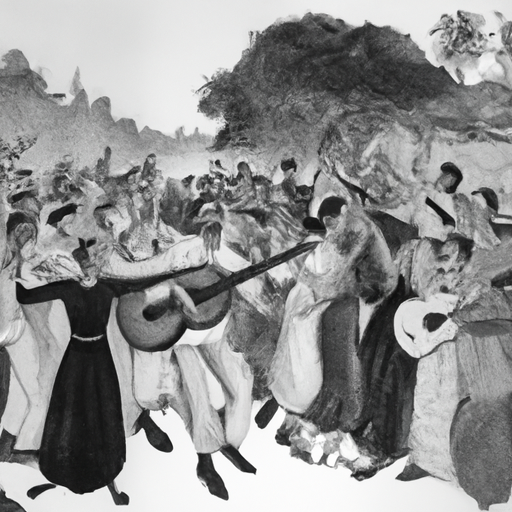Embarking on a musical journey, this blog post explores the depth and dynamism of Israeli Folk Music. Uncovering its historical roots, the influences it absorbed over time, and its transformative journey, we will delve into the echoes of Israel’s diverse cultural landscape as reflected in its folk music. This journey is not just a tale of music, but a reflection of the people, their history, and their resilient spirit.
The Melodious Roots: Where does Israeli Folk Music originate from?
With a history as rich and diverse as the land itself, Israeli Folk Music traces its roots back to the ancient Jewish communities that settled in the region thousands of years ago. Drawing inspiration from biblical texts, traditional melodies, and the cultural practices of various Jewish communities, Israeli Folk Music emerged as a unique blend of musical traditions. The music of the Sephardic Jews from Spain, the Ashkenazi Jews from Eastern Europe, and the Mizrahi Jews from the Middle East all played a role in shaping the distinct sound of Israeli Folk Music.
Over the centuries, Israeli Folk Music has evolved to reflect the ever-changing landscape of the region, incorporating elements from the surrounding cultures and musical styles. The influence of Arab, Bedouin, and other indigenous communities can be heard in the rhythms, instruments, and melodies of Israeli Folk Music. This fusion of traditions has created a vibrant and dynamic musical tapestry that continues to evolve and adapt to contemporary influences.

A black and white image of an early Israeli community gathering, engaged in folk music and dance.
The Cultural Symphony: How did diverse cultures influence Israeli Folk Music?
Israeli Folk Music is a true cultural symphony, with influences from a wide array of traditions and musical styles shaping its unique sound. The music of the Sephardic Jews, with its intricate melodies and poetic lyrics, brought a sense of romance and nostalgia to Israeli Folk Music. Similarly, the lively klezmer music of the Ashkenazi Jews added a dynamic and energetic element to the music, incorporating the sounds of clarinets, violins, and accordions. These diverse influences blended with the rhythms and instruments of the Mizrahi Jews, creating a rich and diverse musical landscape that continues to evolve.
The Arab and Bedouin communities living in the region also played a significant role in shaping Israeli Folk Music, bringing with them their own musical traditions and instruments. The haunting melodies of Arabic music, the rhythmic beats of Bedouin drumming, and the intricate ornamentation of Middle Eastern scales all found their way into the fabric of Israeli Folk Music. This cross-pollination of musical styles resulted in a fusion of sounds that is both captivating and evocative, reflecting the shared history and cultural exchanges that have taken place in the region over the centuries.
“Music is the universal language of mankind” – The Evolution of Israeli Folk Music
“Music is the universal language of mankind” – a timeless quote that perfectly encapsulates the essence of Israeli Folk Music. This genre has undergone a fascinating evolution, reflecting the changing dynamics of Israeli society and the world at large. From its early roots in the kibbutzim and pioneering settlements of pre-state Israel to its modern-day interpretations in bustling cities and international stages, Israeli Folk Music has retained its ability to connect people from all walks of life. The power of music to transcend boundaries and spark emotions has been a driving force behind the evolution of Israeli Folk Music, allowing it to adapt and grow while staying true to its roots.
As Israeli society has evolved, so too has its music, with Israeli Folk Music serving as a mirror to the cultural, social, and political landscape of the country. Themes of love, longing, hope, and resilience are woven into the fabric of Israeli Folk Music, reflecting the joys and struggles of the Israeli experience. The evolution of Israeli Folk Music has also been shaped by technological advancements and globalization, allowing for greater accessibility and exposure to a global audience. This has led to collaborations with musicians from around the world, further enriching the tapestry of Israeli Folk Music with new sounds and perspectives.

An image of an old record player with vinyl records of Israeli folk music, symbolizing its evolution over time.
Where is Israeli Folk Music heading? The Future and Beyond.
Where is Israeli Folk Music heading? The Future and Beyond. As we look ahead, it is clear that Israeli Folk Music is poised to continue its journey of evolution and innovation. With a new generation of talented musicians emerging, the future of Israeli Folk Music is bright and full of promise. These artists are blending traditional sounds with contemporary influences, creating a fresh and vibrant musical landscape that resonates with audiences both in Israel and around the world.
The global reach of Israeli Folk Music is expanding, thanks to the power of digital platforms and social media. Artists are able to connect with fans worldwide, sharing their music and stories with a diverse audience. This increased connectivity is breaking down barriers and fostering a sense of unity and understanding through the universal language of music. Israeli Folk Music is no longer confined to a specific region or audience; it is crossing borders and reaching people from all walks of life.
Israeli Folk Music is more than just a genre; it’s a tangible testament to a nation’s history and cultural evolution. As we’ve journeyed through its rich and complex tapestry, we realize that it’s more than just melody and rhythm. It’s a reflection of the Israeli spirit – resilient, diverse, and filled with a deep love for their heritage. As the music continues to evolve, it will undoubtedly continue to tell the tale of its people, resonating with the heartbeat of Israel.
